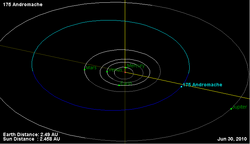Astronomy:175 Andromache
 Orbital diagram | |
| Discovery | |
|---|---|
| Discovered by | J. C. Watson |
| Discovery date | 1 October 1877 |
| Designations | |
| (175) Andromache | |
| Pronunciation | /ænˈdrɒməkiː/[1] |
| Named after | Andromache |
| A877 TA; 1893 KA; 1895 XB; 1946 MB; 1946 OD | |
| Minor planet category | Main belt |
| Orbital characteristics[2] | |
| Epoch 31 July 2016 (JD 2457600.5) | |
| Uncertainty parameter 0 | |
| Observation arc | 138.18 yr (50472 d) |
| |{{{apsis}}}|helion}} | 3.9264 astronomical unit|AU (587.38 Gm) |
| |{{{apsis}}}|helion}} | 2.4442 AU (365.65 Gm) |
| 3.1853 AU (476.51 Gm) | |
| Eccentricity | 0.23267 |
| Orbital period | 5.69 yr (2076.5 d) |
| Mean anomaly | 35.697° |
| Mean motion | 0° 10m 24.132s / day |
| Inclination | 3.2184° |
| Longitude of ascending node | 21.353° |
| 320.41° | |
| Earth MOID | 1.43641 AU (214.884 Gm) |
| Jupiter MOID | 1.4787 AU (221.21 Gm) |
| TJupiter | 3.153 |
| Physical characteristics | |
| Rotation period | 8.324 h (0.3468 d) |
| C | |
| Absolute magnitude (H) | 8.06[3] 8.31[2] |
175 Andromache (minor planet designation: 175 Andromache) is a main-belt asteroid that was discovered by Canadian-American astronomer J. C. Watson on October 1, 1877, and named after Andromache, wife of Hector during the Trojan War. Watson's telegram to Europe announcing the discovery became lost, and so notification did not arrive until several weeks later. As a result, another minor planet, later designated 176 Iduna, was initially assigned the number 175.[4]
The initial orbital elements for 175 Andromache proved unreliable, and it was only in 1893 that an accurate ephemeris was produced. Because the orbital period is fairly close to being double that of the giant planet Jupiter, 175 Andromache initially became of interest in the study of gravitational perturbations.[4][5]
Based upon its spectrum, this is classified as a C-type asteroid.[6] It has a diameter estimated in the range 101–107 km with a roughly circular shape. The size ratio between the major and minor axes is 1.09 ± 0.09, as determined from the W. M. Keck Observatory. An earlier result published in 2000 gave a larger size ratio of 1.20.[7]
References
- ↑ Noah Webster (1884) A Practical Dictionary of the English Language
- ↑ 2.0 2.1 Yeomans, Donald K., "175 Andromache", JPL Small-Body Database Browser (NASA Jet Propulsion Laboratory), https://ssd.jpl.nasa.gov/sbdb.cgi?sstr=175, retrieved 6 May 2016.
- ↑ Warner, Brian D. (December 2007), "Initial Results of a Dedicated H-G Project", The Minor Planet Bulletin 34 (4): 113–119, Bibcode: 2007MPBu...34..113W.
- ↑ 4.0 4.1 Leuschner, A. O. (April 1936), "The Story of Andromache, an Unruly Planet", Publications of the Astronomical Society of the Pacific 48 (282): 57–60, doi:10.1086/124659, Bibcode: 1936PASP...48...55L.
- ↑ Leuschner, A. O. (July 1922), "Comparison of Theory with Observation for the Minor planets 10 Hygiea and 175 Andromache with Respect to Perturbations by Jupiter", Proceedings of the National Academy of Sciences of the United States of America 8 (7): 170–173, doi:10.1073/pnas.8.7.170, PMID 16586868, Bibcode: 1922PNAS....8..170L.
- ↑ Lazzarin, M. et al. (December 1995), "Visible Spectroscopy of Dark, Primitive Asteroids", Astronomical Journal 110: 3058–3072, doi:10.1086/117747, Bibcode: 1995AJ....110.3058L.
- ↑ Marchis, F. et al. (November 2006), "Shape, size and multiplicity of main-belt asteroids. I. Keck Adaptive Optics survey", Icarus 185 (1): 39–63, doi:10.1016/j.icarus.2006.06.001, PMID 19081813, Bibcode: 2006Icar..185...39M.
External links
- 175 Andromache at AstDyS-2, Asteroids—Dynamic Site
- 175 Andromache at the JPL Small-Body Database
 |

